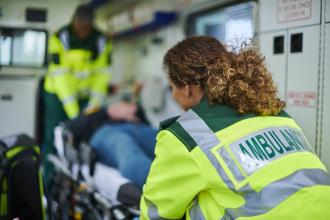WorkSafeBC’s multimodal approach to chronic noncancer pain management: New hotline for physicians
British Columbia continues to have record numbers of illicit drug overdose deaths. Currently, ongoing and multisectorial efforts are contributing to a better understanding of the factors characterizing or contributing to the overdose epidemic. Recent BC Coroners data[1] indicate there were 1489 suspected illicit drug overdose deaths in 2018 (approximately four deaths per day), similar to the previous year. The data also indicate that illicit fentanyl was detected in more than 80% of those deaths, more than 70% of those who died were aged 30 to 59, and more than 80% were males.[1] An earlier descriptive analysis of overdose deaths in BC in 2016–17 indicates that 44% of those who died were employed at the time of death.[2,3]
The National Institute for Occupational Safety and Health (NIOSH) recently launched a framework addressing workplace factors in the opioid epidemic. Elements of the framework emphasize the need for improved understanding of risk factors associated with the workplace, such as history of workplace injuries and prescription opioids. An improved understanding and determination of occupations and workers at risk for opioid overdose can also help inform the response to the opioid epidemic.[4]
Opioid pain medication is associated with risks including overdose and opioid use disorder. WorkSafeBC has been developing best practices and alternatives in managing long-term chronic noncancer pain through a multifaceted Opioids Harm Reduction Program. The program includes ongoing education on topics such as appropriate opioid prescriptions, opiate agonist treatment, and evidence-based treatment of chronic pain.
WorkSafeBC’s practical experience provides clear evidence that long-term use of opioids typically yields few long-term improvements in pain and function.[5] Recognizing the lack of benefits and the risk of harms from prolonged opioid use in managing chronic noncancer pain, WorkSafeBC issued practice directive #C10-1, “Claims with opioids, sedative/hypnotics or other prescribed potentially addictive drugs,” which is available on www.worksafebc.com. The practice directive provides prescription timelines, recommended dosages, and a schedule of opioid follow-up reviews.
During the past 2 years WorkSafeBC content experts have been delivering an outreach program to health care providers. The sessions, “Not just a prescription pad: A multimodal approach to chronic pain management,” are free for attendees, fully accredited, and aligned with the College of Physicians and Surgeons of BC’s practice standards for the safe prescribing of opioids. The workshops address best practices in safe prescribing of opioids; tapering, substitution, and exit strategies; various pharmacological and nonpharmacological strategies for the treatment of chronic noncancer pain; and community resources, including WorkSafeBC programs available to injured workers with an accepted WorkSafeBC claim (list of rehabilitation programs and services is available on www.worksafebc.com). The intent is to bring together community health care providers such as physicians, nurse practitioners, pharmacists, and physiotherapists to help develop collaboration and capacity at the local level. In 2018, WorkSafeBC hosted 11 sessions in communities across the province reaching 230 attendees, of whom 73% were family physicians or residents and 11% were nurse practitioners.
In 2019, WorkSafeBC is offering the following evening workshops, with dinner included:
- 2 May in Kelowna
- 24 May in Nanaimo
- 31 May in Prince George
- 20 June in Dawson Creek/Fort St. John
- 18 October in Kelowna
Register online at https://events.eply.com/chronicpain or call 1 877 231-8765 for these and other workshops to be scheduled in Cranbrook, Salmon Arm, Vancouver, and Vernon. Seating is limited.
WorkSafeBC hotline for physicians
As part of the Opioids Harm Reduction Program, WorkSafeBC has launched a new hotline staffed by in-house medical experts who offer counseling and support to community prescribers in management of opioids, tapering, nonpharmaceutical strategies, harm reduction programs, community resources, and referrals for WorkSafeBC injured workers. The toll-free hotline number is 1 855 476-3049, and is staffed between 8:30 a.m. and 4:30 p.m., Monday to Friday.
—Peter Rothfels, MD
WorkSafeBC Chief Medical Officer and Director of Clinical Services
—Olivia Sampson, MD, CCFP, MPH, FRCPC, ABPM
WorkSafeBC Manager of Clinical Services
hidden
This article is the opinion of WorkSafeBC and has not been peer reviewed by the BCMJ Editorial Board.
References
1. Coroners Service. Ministry of Public Safety and Solicitor General. Illicit drug overdose deaths in BC. January 1, 2018 – December 31, 2018. Accessed 28 February 2019. https://www2.gov.bc.ca/gov/content/life-events/death/coroners-service/statistical-reports.
2. Coroners Service. Ministry of Public Safety and Solicitor General. Illicit drug overdose deaths in BC. Findings of Coroners’ investigations. 27 September 2018. Accessed 27 March 2019. https://www2.gov.bc.ca/assets/gov/birth-adoption-death-marriage-and-divorce/deaths/coroners-service/statistical/illicitdrugoverdosedeathsinbc-findingsofcoronersinvestigations-final.pdf.
3. BC Ministry of Mental Health and Addictions. Responding to BC’s illegal drug overdose epidemic. Progress update. August/September/October 2018. Accessed 27 March 2019. https://www2.gov.bc.ca/assets/gov/health/about-bc-s-health-care-system/office-of-the-provincial-health-officer/overdose-response-progress-update-aug-sept-oct-2018.pdf.
4. Harduar Morano L, Steege AL, Luckhaupt SE. Occupational patterns in unintentional and undetermined drug-involved and opioid-involved overdose deaths—United States, 2007–2012. MMWR Morb Mortal Wkly Rep 2018;67:925-930.
5. Rothfels P. Best practices in treating chronic noncancer pain. BCMJ 2018;60:244,269.

